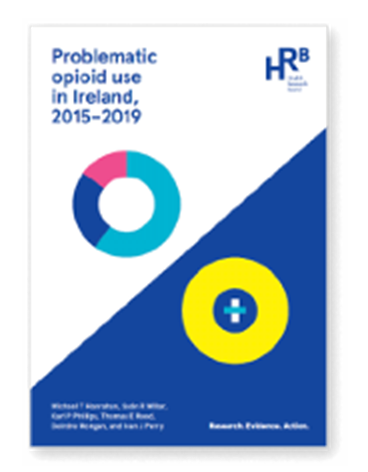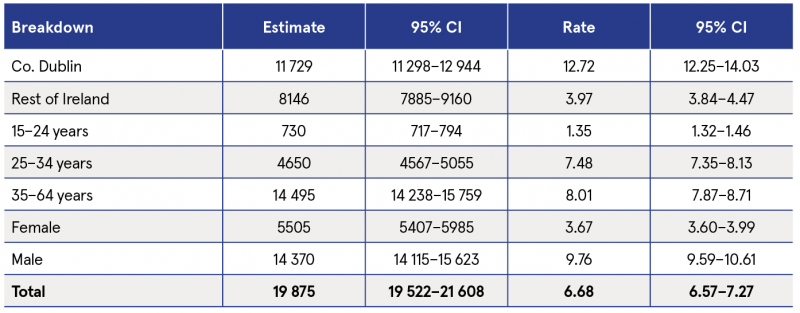Millar, Sean  ORCID: https://orcid.org/0000-0003-4453-8446
(2023)
New estimates of problematic opioid use in Ireland, 2015–2019.
Drugnet Ireland,
Issue 84, Winter 2023,
pp. 1-3.
ORCID: https://orcid.org/0000-0003-4453-8446
(2023)
New estimates of problematic opioid use in Ireland, 2015–2019.
Drugnet Ireland,
Issue 84, Winter 2023,
pp. 1-3.
| Preview | Title | Contact |
|---|---|---|
|
PDF (Drugnet 84)
1MB |
Background
Problematic opioid use is a significant problem in Ireland and across the world. However, measuring the prevalence of opioid use is challenging. Given the nature of this population, a simple head count is not feasible and general population surveys are known to be ineffective at capturing this ‘hidden’ population. Because people who use drugs fear stigmatisation and are often marginalised in society, the European Monitoring Centre for Drugs and Drug Addiction (EMCDDA) recommends the use of indirect approaches, such as the capture–recapture (CRC) method, to estimate the prevalence of problematic (high-risk) drug users.
A national three-source CRC study to provide statistically valid estimates of the prevalence of opioid drug use in the national population was commissioned by the National Advisory Committee on Drugs and Alcohol and undertaken in 20011 and again in 2006.2 The three data sources used were the Central Treatment List (of clients on methadone), the Hospital In-Patient Enquiry (HIPE) scheme, and An Garda Síochána PULSE (Police Using Leading Systems Effectively) data. A third study using the CRC method was published in 2017.3
In 2020, the Health Research Board (HRB) awarded a contract to the School of Public Health at University College Cork to conduct a fourth study on the prevalence of opioid use in the Republic of Ireland for the years 2015–2019. The methodology and main findings from this study are discussed below.4

Methods
Data on opioid use for the years 2015–2019 were collected from four sources: treatment clinics, general practitioners (GPs), the Irish Prison Service, and the Probation Service. Employing the CRC method, Poisson log-linear models were applied to the overlap data to find the model with the best fit to estimate the hidden population not identified by any of the data sources. Source-by-source interaction terms were tested by adding them to the base model in all possible combinations. The best model for estimating the size of the hidden population was determined by comparing the deviance to the chi-squared distribution and the Akaike information criterion (AIC) value. The simplest model with the lowest AIC value that provided a credible estimate was used.
Results
Table 1 summarises the main results of the study, stratified by Co. Dublin/rest of Ireland as well as by age group and sex. In total, there were an estimated 19,875 problematic opioid users in Ireland in 2019 (95% confidence interval [CI]: 19 522–21 608), which equates to a prevalence rate of 6.68 per 1,000 population (95% CI: 6.57–7.27). The majority of problematic opioid users were male (72.3%) and more than two-thirds (72.93%) of problematic opioid users were in the older 35–64-years age group. There were an estimated 11,729 problematic opioid users (95% CI: 11 298–12 944) in Co. Dublin in 2019, with a rate over three times higher there than in the rest of Ireland (12.72 per 1,000 population) (95% CI: 12.25–14.03) versus 3.97 per 1,000 population (95% CI: 3.84–4.47).
Data for the prevalence of problematic opioid use for the years 2015, 2016, 2017 and 2018 are additionally presented to provide information on changes in trends over time (see Table 2). While there was a slight decrease in the overall number of opioid users between 2015 and 2019, this decrease was not statistically significant. The prevalence of problematic opioid use among younger age groups (15–24-year-olds and 25–34-year-olds) (see Tables 3 and 4) also appears to be in decline, while the number of problematic opioid users in the older age group (35–64 years) has increased (see Table 5).
Table 1: Summary of prevalence estimates of problematic opioid use (2019)

Source: Hanrahan et al., 2022
Table 2: Comparison of the number of problematic opioid users and rates per 1,000 population aged 15 to 64 years (2015–2019)

Source: Hanrahan et al., 2022
Table 3: Comparison of the number of problematic opioid users and rates per 1,000 population aged 15 to 24 years (2015–2019)

Source: Hanrahan et al., 2022
Table 4: Comparison of the number of problematic opioid users and rates per 1,000 population aged 25 to 34 years (2015–2019)

Source: Hanrahan et al., 2022
Table 5: Comparison of the number of problematic opioid users and rates per 1,000 population aged 35 to 64 years (2015–2019)

Source: Hanrahan et al., 2022
Conclusions
Commenting on the study’s findings, Dr Michael Hanrahan, who led the data collection and analyses, said:
The decline in opioid use among young people is a positive development and could be attributed to the negative image of heroin among young people or the provision of prompt treatment that can break a cycle whereby opioid users introduce the drug to others, or a combination of these factors. This finding should also be viewed in light of recent data from the HRB’s National Drug and Alcohol Survey,5 which found that the use of stimulant-type drugs such as cocaine and ecstasy has increased among younger age groups since 2014.6
1 Kelly A, Carvalho M and Teljeur C (2003) Prevalence of opiate use in Ireland 2000–2001: a 3-source capture recapture study. Dublin: Stationery Office. https://www.drugsandalcohol.ie/5942/
2 Kelly A, Teljeur C and Carvalho M (2009) Prevalence of opiate use in Ireland 2006: a 3-source capture recapture study. Dublin: Stationery Office. https://www.drugsandalcohol.ie/12695/
3 Hay G, Jaddoa A, Oyston J, Webster J, Van Hout MC and Rael dos Santos A (2017) Estimating the prevalence of problematic opiate use in Ireland using indirect statistical methods. Dublin: National Advisory Committee on Drugs and Alcohol. https://www.drugsandalcohol.ie/27233/
4 Hanrahan MT, Millar SR, Phillips KP, Reed TE, Mongan D and Perry IJ (2022) Problematic opioid use in Ireland, 2015–2019. Dublin: Health Research Board. https://www.drugsandalcohol.ie/35856/
5 Mongan D, Millar SR and Galvin B (2021) The 2019–20 Irish National Drug and Alcohol Survey: main findings. Dublin: Health Research Board. https://www.drugsandalcohol.ie/34287/
6 Health Research Board (2022) HRB report shows a decline in problem opioid use among younger age groups [Press release]. Dublin: Health Research Board. Available from: https://www.hrb.ie/news/press-releases/single-press-release/article/hrb-report-shows-a-decline-in-problem-opioid-use-among-younger-age-groups/
A Substance use and dependence > Prevalence > Substance use behaviour
B Substances > Opioids (opiates)
G Health and disease > Substance use disorder (addiction) > Drug use disorder
J Health care, prevention, harm reduction and treatment > Health services, substance use research
VA Geographic area > Europe > Ireland
Repository Staff Only: item control page